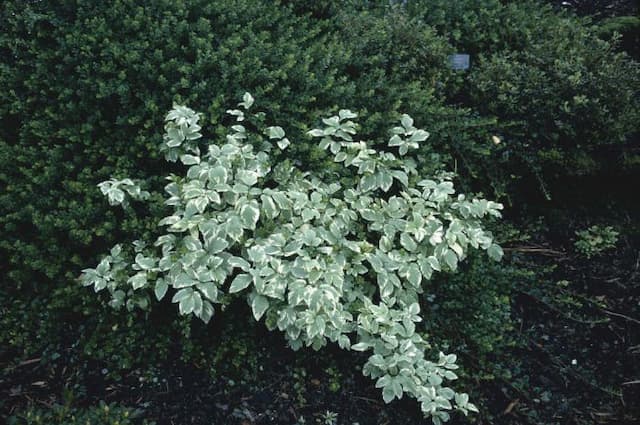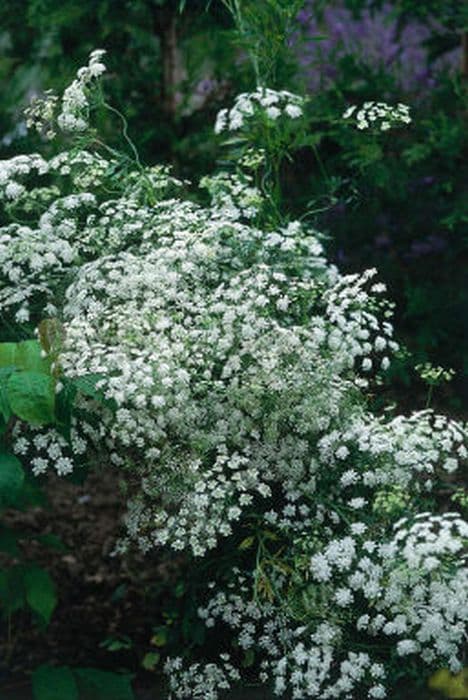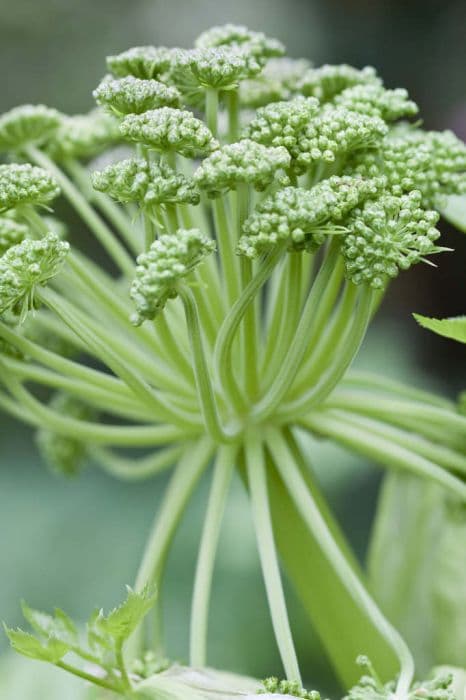Moroccan Sea Holly Eryngium bourgatii Graham Stuart Thomas's selection

ABOUT
Eryngium bourgatii, commonly known as Mediterranean Sea Holly, is an eye-catching perennial herbaceous plant. The Graham Stuart Thomas's selection is particularly noted for its striking appearance. The plant features a rosette of deeply lobed, spiny leaves that are often silvery-green in color, providing a dramatic and somewhat architectural feel to the foliage. The leaves typically have a marbled or veined appearance with white markings, which adds to the visual interest of the plant. During the blooming period, Mediterranean Sea Holly produces cone-shaped flower heads that are surrounded by a ruff of spiny bracts. These flowers and bracts are usually a metallic blue or bluish-purple, lending a unique color palette to the garden. The stems of the plant are branched and upright, holding the flower heads aloft, creating a striking display. The contrasting colors and textures—the silvery leaves against the blue of the flowers—give the Mediterranean Sea Holly a distinctive and somewhat exotic appearance, making it a focal point in any garden setting where it's grown. The overall impression of the plant is one of strength, texture, and vivid color contrasts, making it popular among gardeners looking for plants with strong visual impact.
About this plant
 Names
NamesFamily
Apiaceae
Synonyms
Mediterranean Sea Holly, Bourgat's Sea Holly
Common names
Eryngium bourgatii
 Toxicity
ToxicityTo humans
Sea holly, specifically the Eryngium bourgatii Graham Stuart Thomas's selection, is not widely reported to be toxic to humans. There is limited information on the ingestion of this plant by humans, and it is generally considered not poisonous. Therefore, no specific symptoms of poisoning or toxicity consequences are commonly associated with it.
To pets
Sea holly is not commonly known to be toxic to pets such as cats and dogs. There is limited information on pet ingestion, but it is generally not considered to have poisonous effects. Therefore, there are no specific symptoms or toxicity consequences associated with pets ingesting this plant. However, as with any non-food plant, ingestion can potentially cause mild stomach upset or an allergic reaction, so it is always best to prevent pets from eating ornamental plants.
 Characteristics
CharacteristicsLife cycle
Perennials
Foliage type
Deciduous
Color of leaves
Green
Flower color
Blue
Height
2 feet (60 cm)
Spread
1 feet (30 cm)
Plant type
Herb
Hardiness zones
5
Native area
Mediterranean
Benefits
 General Benefits
General Benefits- Ornamental value: Eryngium bourgatii 'Graham Stuart Thomas's selection' has striking foliage and flowers that add visual interest to gardens and landscapes.
- Drought tolerance: Once established, it requires minimal water, making it suitable for xeriscaping and water-efficient gardening.
- Attracts wildlife: The flowers are known to attract bees, butterflies, and other beneficial insects, promoting biodiversity.
- Low maintenance: It’s generally resistant to pests and diseases, reducing the need for chemical treatments and frequent care.
- Soil adaptability: It can thrive in various soil types, including poor soils, as long as they have good drainage.
- Long blooming period: The plant has a long flowering season, providing color and interest in the garden for an extended time.
- Versatility in landscape design: It can be used in various garden styles, including rock gardens, borders, and coastal gardens.
- Non-invasive: It does not aggressively spread, making it a responsible choice for maintaining ecological balance.
- Deer resistance: The plant is not favored by deer, which can be beneficial in areas where deer browsing is a problem.
- Cold hardiness: It is hardy in cold temperatures, making it suitable for planting in a range of climates.
 Medical Properties
Medical Properties- This plant is not used for medical purposes.
 Air-purifying Qualities
Air-purifying QualitiesThis plant is not specifically known for air purifying qualities.
 Other Uses
Other Uses- Culinary enhancement: The roots of Eryngium bourgatii, also known as Sea Holly, can be used as a spice due to their intense flavor, reminiscent of a milder version of its relative, the horseradish.
- Dried arrangements: Sea Holly's striking blue flowers and thistle-like appearance make it an excellent choice for dried flower arrangements, adding texture and visual interest.
- Garden borders: This plant is a popular choice for adding structure to perennial garden borders, thanks to their upright growth habit and unique foliage color.
- Wildlife habitat: Sea Holly provides nectar for bees, butterflies, and other pollinating insects, making it a beneficial addition to wildlife gardens.
- Erosion control: Their robust root system can help to stabilize soil and prevent erosion on slopes or in coastal areas.
- Floral art: The unusual shapes and textures of Sea Holly are often used by florists to create avant-garde and sculptural floral designs.
- Theme gardens: Due to its unique appearance, Eryngium bourgatii is suitable for medieval or historical theme gardens, replicating the look of a bygone era.
- Container gardening: Sea Holly can also be grown in containers where it can thrive in the well-drained conditions it prefers.
- Tattoo inspiration: The distinctive form of Sea Holly is sometimes used as a motif or inspiration for tattoo designs, symbolizing rugged beauty and resilience.
- Photography subject: With its striking appearance, Sea Holly is a favorite among garden photographers and plant enthusiasts for its photogenic qualities.
Interesting Facts
 Feng Shui
Feng ShuiThe Sea Holly is not used in Feng Shui practice.
 Zodiac Sign Compitability
Zodiac Sign CompitabilityThe Sea Holly is not used in astrology practice.
 Plant Symbolism
Plant Symbolism- Protection: Eryngium bourgatii, commonly known as Mediterranean Sea Holly, has a spiky appearance that symbolizes protection and defense.
- Persistence: Its ability to grow in poor soil and tough conditions represents endurance and determination.
- Independence: Mediterranean Sea Holly’s unique and distinct form signifies independence and a strong sense of self.
- Attraction: The metallic blue color and unusual shape of the blooms are associated with allure and fascination, making it emblematic of attraction.
 Water
WaterSea Holly should be watered thoroughly once a week during its growing season, allowing the soil to dry out slightly between waterings. In hotter, drier periods, watering frequency should be increased to twice a week. When watering, apply approximately 1 gallon of water per plant to ensure deep soil penetration, promoting the growth of strong, deep roots. During winter, reduce watering significantly, as the plant is dormant and excess moisture can lead to root rot. Always check the top inch of soil for dryness before watering to prevent overhydration.
 Light
LightSea Holly thrives best in full sun, where it can receive at least 6-8 hours of direct sunlight daily. Place the plant in a south-facing spot in the garden to ensure it gets ample light. Avoid shaded areas, as too little sun can lead to poor flowering and weak growth.
 Temperature
TemperatureSea Holly grows well in temperate climates and can tolerate a wide range of temperatures, withstanding winter lows down to 5°F and summer highs up to 90°F. However, the ideal temperature range for optimal growth is between 60°F and 75°F.
 Pruning
PruningSea Holly should be pruned to remove spent flowers and encourage bushier growth, usually done after the blooming period in late summer. Cut the flower stems back to the base of the plant. Pruning is not required frequently but doing it annually can help maintain the plant's shape and vigor.
 Cleaning
CleaningAs needed
 Soil
SoilFor Sea Holly, a well-draining soil mix with sharp sand, gravel, or perlite is essential; it thrives in poor to moderately fertile soils. The ideal soil pH should range between 6.0 and 7.5, which is slightly acidic to neutral.
 Repotting
RepottingSea Holly typically does not require frequent repotting; it can be done every 2-3 years or when it outgrows its current container.
 Humidity & Misting
Humidity & MistingSea Holly thrives in average humidity conditions; it does not have specific humidity requirements but prefers a drier environment.
 Suitable locations
Suitable locationsIndoor
Provide full light, minimal water, lean soil for Sea Holly.
Outdoor
Choose sunny spot, well-draining soil for Sea Holly.
Hardiness zone
5-9 USDA
 Life cycle
Life cycleEryngium bourgatii 'Graham Stuart Thomas' selection, commonly known as Mediterranean Sea Holly, begins its life cycle with seed germination, occurring under suitable conditions of temperature and light. The seedlings grow into rosettes, producing a low cluster of heart-shaped basal leaves. As the plant matures, it develops a stout flowering stem with spiny-toothed leaves and produces distinctive, cone-shaped flower heads surrounded by spiky bracts, usually in blue or silver tones, in the summer. After pollination, which is primarily performed by insects attracted to the flowers, seeds are produced for the next generation. The plant is a perennial, so above-ground parts die back in autumn, but the root system remains alive over winter, allowing the plant to re-emerge and grow in the following spring. Each individual can go through this cycle for several years depending on environmental conditions and care.
 Propogation
PropogationPropogation time
Spring to summer
Eryngium bourgatii, commonly known as Sea Holly, is often propagated by seed. The best time to sow Sea Holly seeds is in late winter to early spring, while ensuring that there is still potential for a bit of frost, as a cold spell can help to break the seed's dormancy. The seeds should be sown in well-draining soil at a depth of about 1/8 inch (approximately 3 mm) and preferably in a location that gets full sun throughout the day. Seedlings typically emerge when temperatures start to warm up in spring. Upon germination, seedlings should be thinned out or transplanted to allow ample space for the mature plants to develop. This plant can also be propagated by root division in early spring or autumn, but sowing seeds tends to be the more popular method due to its simplicity and effectiveness.









